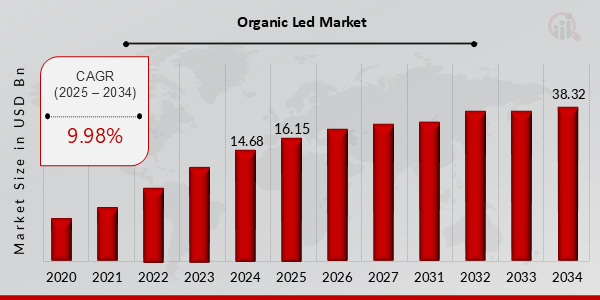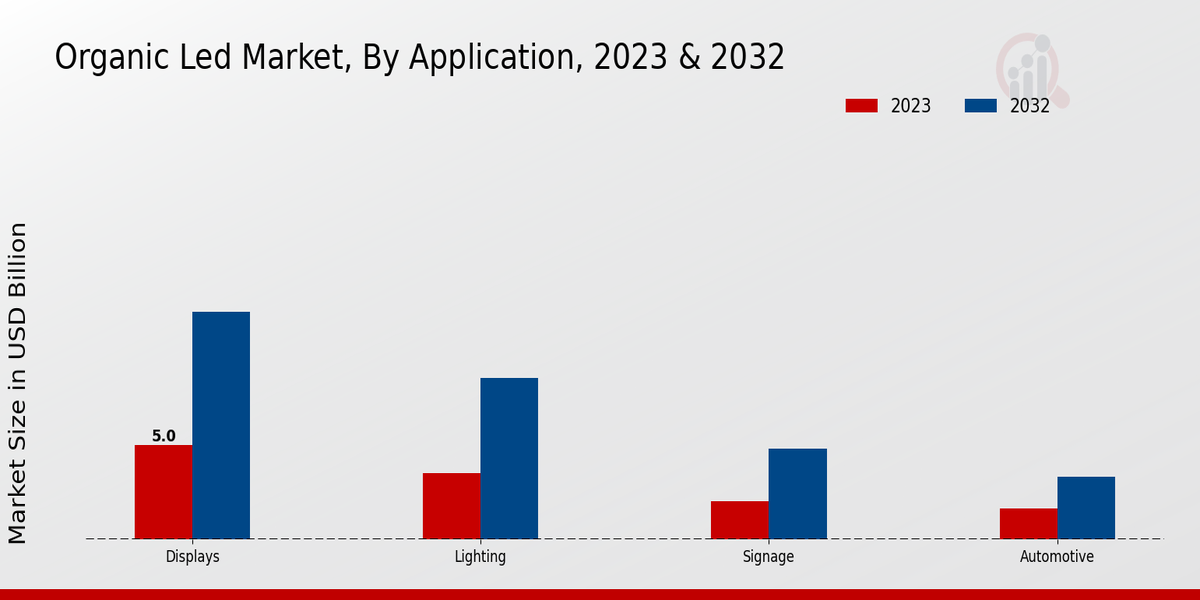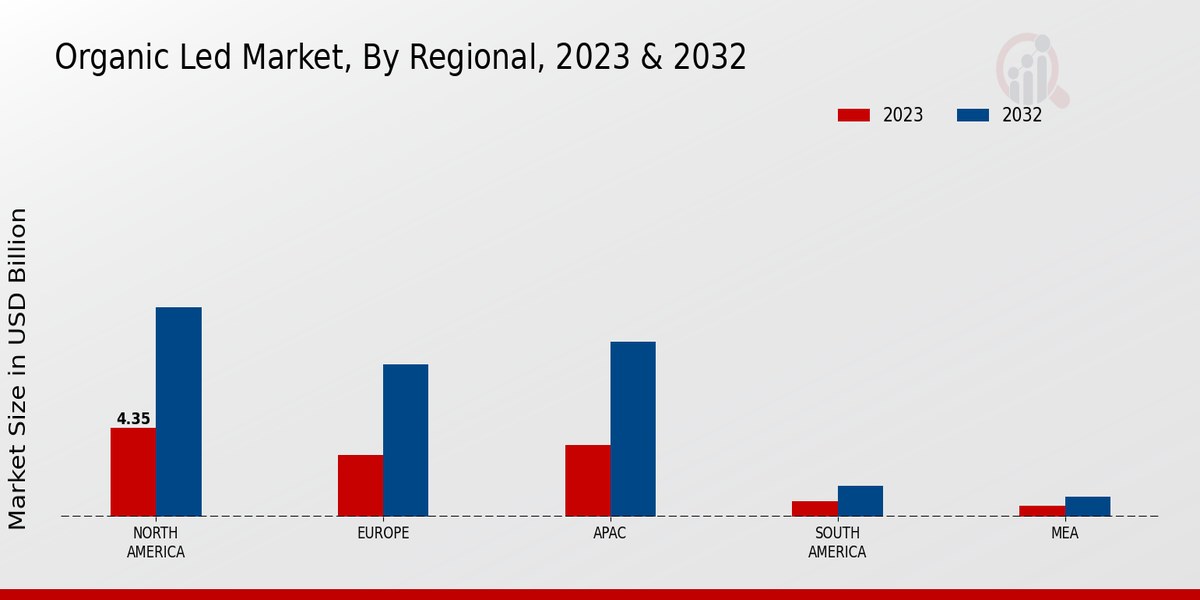Global Organic LED Market Overview
Organic Led Market Size was estimated at 14.68 (USD Billion) in 2024. The Organic Led Market Industry is expected to grow from 16.15 (USD Billion) in 2025 to 38.32 (USD Billion) till 2034, exhibiting a compound annual growth rate (CAGR) of 9.98% during the forecast period (2025 - 2034)
Key Organic LED Market Trends Highlighted
The Organic LED Market is experiencing significant growth driven by the increasing demand for energy-efficient lighting solutions. As consumers and businesses become more conscious of their environmental impact, the shift towards sustainable technologies has accelerated. OLED technology is recognized for its lower energy consumption and its ability to provide high-quality lighting. This growing awareness, along with advancements in OLED technology, positions it as a vital alternative for various applications, such as displays in electronics and lighting solutions in commercial and residential spaces. Opportunities to be explored in the market include expanding applications of OLED in the automotive industry and the rise of smart devices.The integration of OLED technology in next-generation smartphones, wearables, and smart home systems presents a significant avenue for growth. Additionally, emerging markets are beginning to embrace OLED technology, leading to increased demand and potential investment in these regions. Trends in recent times highlight a strong emphasis on research and development of flexible and transparent OLED displays, enhancing their versatility and aesthetic appeal. The industry is also seeing collaborations between manufacturers and tech companies to innovate and create advanced products. Furthermore, the focus on reducing production costs while maintaining high quality continues to be a pivotal trend, optimizing the supply chain for better efficiency.Increased emphasis on sustainability in manufacturing practices is also shaping the future of the OLED market, as companies aim to align with global environmental standards. Together, these dynamics are fostering an environment of growth and innovation within the Organic LED Market.

Source: Primary Research, Secondary Research, MRFR Database and Analyst Review
Organic LED Market Drivers
Increasing Demand for Energy-Efficient Displays
The Organic LED Market Industry is witnessing a significant rise in demand for energy-efficient display technologies across various sectors, including consumer electronics, automotive and advertising. Organic LEDs (OLEDs) offer distinct advantages over traditional display technologies such as LCD and LED, particularly in terms of energy consumption, color accuracy and contrast ratio. As the global shift toward sustainability and energy conservation gathers momentum, manufacturers and consumers alike are increasingly favoring OLED displays for their lower power consumption and higher efficiency.This preference aligns with regulatory trends aimed at reducing energy usage and greenhouse gas emissions. Furthermore, the growing awareness of environmental issues and the need for sustainable solutions have spurred innovation in the OLED space, leading to advancements in materials and manufacturing processes that enhance energy efficiency. As a result, the demand for OLED technology is expected to surge, significantly contributing to the growth of the Organic LED Market in the coming years.
Expansion of Smart Technology Integration
The integration of smart technology into everyday devices is a crucial driver for the Organic LED Market Industry. With the rapid proliferation of smart devices, including smartphones, tablets, and smart TVs, the demand for advanced display technologies like OLEDs is escalating. OLED displays provide superior image quality and greater flexibility in design, allowing for innovative form factors such as curved and foldable screens. This trend not only enhances user experience but also opens up new opportunities for application in various sectors.As more smart devices incorporate OLED technology, the market is expected to witness significant growth, driven by consumer preference for high-quality displays.
Rising Adoption of OLEDs in Automotive Applications
The automotive industry is increasingly recognizing the potential of OLED technology, leading to its growing adoption of in-vehicle displays and lighting components. The Organic LED Market Industry is benefitting from this trend as automakers seek to enhance the aesthetic appeal of vehicle interiors and improve the overall user experience. OLEDs offer advantages such as lightweight design, thin profile, and customization capabilities, making them ideal for dashboard displays, instrument clusters, and ambient lighting solutions.As the automotive sector continues to innovate and prioritize advanced technologies, the integration of OLEDs is poised to play a significant role in shaping the future of vehicle displays.
Organic LED Market Segment Insights
Organic LED Market Application Insights
The Organic LED Market, segmented by Application, showcases a diverse and growing landscape that reflects the increasing adoption of OLED technology across various channels. As of 2023, this market holds significant value at 12.14 USD Billion, with forecasts indicating that it could grow substantially to 28.6 USD Billion by 2032. Within this segmentation, Displays emerged as the leading category, being valued at 5.0 USD Billion in 2023 and projected to reach 12.0 USD Billion by 2032, demonstrating a strong majority holding that underscores the critical role displays play in consumer electronics, televisions, and mobile devices.Lighting follows, with a worth of 3.5 USD Billion in 2023 and a potential growth to 8.5 USD Billion by 2032, highlighting the rising demand for energy-efficient and aesthetically pleasing lighting solutions across residential and commercial spaces. The Signage segment accounts for 2.0 USD Billion in 2023, expected to grow to 4.8 USD Billion by 2032, driven by the increasing utilization of digital signage in advertising and presentation settings, marking it as a key driver for market growth. Meanwhile, the Automotive segment, while currently valued at 1.64 USD Billion in 2023, with projections to reach 3.3 USD Billion by 2032, reflects the growing trend towards integrating advanced lighting technologies in vehicles for enhanced safety and design aesthetics.The synergy among these applications showcases the robust potential for advancements in OLED technology, driven by increasing consumer demand and evolving technological landscapes. However, challenges such as production costs and competition from alternative technologies will need addressing to fully realize the market's opportunities. With evident trends toward sustainability, energy efficiency, and consumer electronics innovation, the Organic LED Market continues to gain traction, underscoring its pivotal role in shaping modern visual experiences.

Source: Primary Research, Secondary Research, MRFR Database and Analyst Review
Organic LED Market Material Type Insights
The Organic LED Market is experiencing notable growth; within the Material Type category, three key segments are prominent: Small Molecule Organic LEDs, Polymer Organic LEDs and Hybrid Organic LEDs. Small Molecule Organic LEDs are highly regarded for their efficiency and superior performance, making them a preferred choice in various applications, especially in high-end displays. Meanwhile, Polymer Organic LEDs have gained traction due to their flexibility and suitability for large-area applications, presenting significant opportunities for adoption in innovative product designs.Hybrid Organic LEDs, which combine the strengths of both small molecules and polymers, are also emerging as a compelling option, offering advantages in performance and manufacturing processes. The market growth is driven by increasing demand for energy-efficient displays, advancements in technology, and the rising trend of smart devices. However, challenges such as high production costs and the need for enhanced durability continue to impact market dynamics. Overall, the Organic LED Market segmentation reveals a rich landscape driven by the unique properties and applications each material type brings to the industry.
Organic LED Market End Use Insights
The Consumer Electronics segment significantly dominates the market, driven by the increasing demand for high-quality displays in smartphones, televisions and wearable devices, offering enhanced color accuracy and energy efficiency. Commercial applications, including signage and lighting solutions, also play a vital role, leveraging OLED technology for vibrant displays and lower energy consumption, thereby improving overall operational efficiency.The Industrial segment, while smaller, is gaining traction due to innovations in lighting systems and displays tailored for specific industrial settings. This diverse segmentation illustrates the vast opportunities within the Organic LED Market, as each area exhibits unique growth drivers and trends, contributing to overall market expansion. The ongoing advancements in OLED technology continue to encourage investments and compel stakeholder engagement across these end-use categories, reflecting a promising trajectory for the Organic LED Market data and statistics in the upcoming years.
Organic LED Market Technology Insights
Within this technological segment, Transparent Organic LED, Flexible Organic LED, and Active Matrix Organic LED are playing significant roles. Transparent Organic LED is becoming increasingly popular for its application in developing displays that blend seamlessly with their environments, making urban aesthetics more appealing. Meanwhile, Flexible Organic LED technology is gaining traction due to its adaptability, enabling curved displays in various consumer electronics, which enhances user experiences.Active Matrix Organic LED technology dominates the market, known for its superior performance and efficiency in electronic devices, ensuring clearer images and superior energy consumption compared to traditional methods. These technologies not only contribute to the overall revenue of the Organic LED Market but also reveal a trend toward innovation and sustainability, catering to consumer demand for both improved functionality and energy efficiency. The combination of these factors positions the market well for sustained growth, with a projected value of 28.6 billion USD by 2032, reflecting a strong market growth trajectory.
Organic LED Market Regional Insights
The Organic LED Market is experiencing notable growth across its regional segments, reflecting a burgeoning demand for advanced display technologies. In 2023, North America holds a significant position valued at 4.35 USD Billion, progressing to 10.2 USD Billion by 2032, thereby showcasing its dominance and majority holding in the market. Following this, Europe is valued at 3.0 USD Billion in 2023, expected to grow to 7.4 USD Billion by 2032, indicating robust growth drivers in the region, particularly in consumer electronics and automotive applications.The APAC region, valued at 3.5 USD Billion in 2023, is projected to reach 8.5 USD Billion by 2032, supported by increasing manufacturing capabilities and rising investments in new technologies. Meanwhile, South America and MEA are at earlier growth stages, with valuations at 0.75 USD Billion and 0.54 USD Billion, respectively, in 2023, each expected to double by 2032. Despite their smaller shares, these regions present emerging opportunities driven by rising consumer electronics demand. The varying market growth and significant regional distinctions in the Organic LED Market segmentation underline the necessity for tailored strategies and innovation to seize the rising demand.

Source: Primary Research, Secondary Research, MRFR Database and Analyst Review
Organic LED Market Key Players and Competitive Insights
The Organic LED Market is characterized by a dynamic landscape marked by rapid technological advancements and increasing demand for energy-efficient display solutions. With growing consumer awareness regarding sustainability and the need for high-quality visual experiences, the competitive environment is evolving continuously. Innovative product offerings, advancements in materials science, and rising applications of organic LEDs in various sectors, such as automotive, consumer electronics, and signage, have led to heightened competition among key players. Companies are focusing on strategic partnerships, mergers and acquisitions, and research and development to enhance their market presence and capture a larger share of this lucrative market. The market is also experiencing the entry of several new players, which further intensifies the competitive dynamics.OSRAM Opto Semiconductors has established itself as a formidable player in the Organic LED Market, leveraging its extensive expertise in optoelectronics. The company is recognized for its high-quality organic LED products that meet a wide range of customer demands. Its strengths lie in its innovative research capabilities and a robust portfolio of lighting solutions that provide superior performance and energy efficiency. OSRAM Opto Semiconductors is also well-regarded for its commitment to sustainability and its ability to deliver tailored solutions that cater to diverse applications.
The company's strong market presence is supported by strategic collaborations and a strong distribution network, enabling it to effectively reach customers across various sectors. OSRAM's relentless focus on R&D positions it at the forefront of technological advancements within the organic LED space.BOE Technology Group has made significant strides in the Organic LED Market by positioning itself as a leader in advanced display technologies. The company has established a comprehensive ecosystem that encompasses research, manufacturing, and distribution of organic LED panels, which has enabled it to meet the growing demand for high-resolution displays. BOE Technology Group benefits from its strong investment in innovative manufacturing processes and proprietary technologies that enhance product quality and yield. Its ability to produce large-scale, high-performance organic LED displays at competitive prices has garnered attention and market share. Furthermore, BOE's strategic investments in cutting-edge technologies and collaborations with global partners have reinforced its competitive edge and expanded its footprint in the organic LED market. The company's focus on delivering state-of-the-art display solutions continues to strengthen its position as a key player in this rapidly evolving industry.
Key Companies in the Organic LED Market Include
- OSRAM Opto Semiconductors
- BOE Technology Group
- Konica Minolta
- Nanosys
- OrganiLux
- Universal Display Corporation
- Kyocera Corporation
- Philips
- Sumitomo Chemical
- Taiwan Semiconductor Manufacturing Company
- Merck Group
- LG Display
- Samsung Electronics
- Acreo
- CSOT
Organic LED Industry Developments
The Organic LED Market has been witnessing significant developments recently. Companies such as Universal Display Corporation and LG Display continue to lead advancements in OLED technology, with new innovations aimed at improving efficiency and visual quality. Samsung Electronics has reported substantial growth in its OLED segment, particularly in the smartphone market, leading to an increased demand for high-quality displays. Meanwhile, OSRAM Opto Semiconductors has been focusing on expanding its product range to cater to the growing smart lighting applications that utilize OLEDs. In terms of mergers and acquisitions, significant activity has been observed, including strategic movements involving companies like BOE Technology Group and Sumitomo Chemical, enhancing their market presence and capabilities in OLED production. These trends reflect an overall surge in market valuation as enhanced manufacturing processes and broader applications across industries fuel investments. Additionally, advancements by Nanosys and Kyocera Corporation indicate a growing focus on integrating OLED technology in next-generation devices, thereby driving market growth further. The competitive landscape suggests that collaboration and strategic partnerships will be instrumental in shaping the future of the Organic LED Market.
Organic LED Market Segmentation Insights
Organic LED Market Application Outlook
- Displays
- Lighting
- Signage
- Automotive
Organic LED Market Material Type Outlook
- Small Molecule Organic LED
- Polymer Organic LED
- Hybrid Organic LED
Organic LED Market End Use Outlook
- Consumer Electronics
- Commercial
- Industrial
Organic LED Market Technology Outlook
- Transparent Organic LED
- Flexible Organic LED
- Active Matrix Organic LED
Organic LED Market Regional Outlook
- North America
- Europe
- South America
- Asia Pacific
- Middle East and Africa
|
Report Attribute/Metric
|
Details
|
|
Market Size 2024
|
USD 14.68 Billion
|
|
Market Size 2025
|
USD 16.15 Billion
|
|
Market Size 2034
|
USD 38.32 Billion
|
|
Compound Annual Growth Rate (CAGR)
|
9.98% (2025-2034)
|
|
Base Year
|
2024
|
|
Market Forecast Period
|
2025-2034
|
|
Historical Data
|
2020-2023
|
| Market Forecast Units |
USD Billion |
| Key Companies Profiled |
OSRAM Opto Semiconductors, BOE Technology Group, Konica Minolta, Nanosys, OrganiLux, Universal Display Corporation, Kyocera Corporation, Philips, Sumitomo Chemical, Taiwan Semiconductor Manufacturing Company, Merck Group, LG Display, Samsung Electronics, Acreo, CSOT |
| Segments Covered |
Application, Material Type, End Use, Technology, Regional |
| Key Market Opportunities |
1. Increasing demand for flexible displays, 2. Advances in OLED lighting technology, 3. Growth in automotive OLED applications, 4. Rising adoption of smart devices, 5. Sustainable and eco-friendly solutions |
| Key Market Dynamics |
1. Technological advancements, 2. Growing consumer demand, 3. Energy efficiency regulations, 4. Increasing R investments, 5. Rising adoption of displays |
| Countries Covered |
North America, Europe, APAC, South America, MEA |
Frequently Asked Questions (FAQ) :
The Organic LED Market is expected to reach a value of 38.32 billion USD by the year 2034.
The Organic LED Market is projected to grow at a CAGR of 9.98% from 2025 to 2034.
The Displays application segment is expected to dominate, with a projected value of 12.0 billion USD by 2032.
The Lighting application segment is estimated to achieve a market size of 8.5 billion USD by 2032.
North America is projected to hold the largest market share, with an expected value of 10.2 billion USD by 2032.
The Automotive application segment is expected to reach a market size of 3.3 billion USD by 2032.
Major players in the Organic LED Market include OSRAM Opto Semiconductors, BOE Technology Group, and Universal Display Corporation.
The Signage application is projected to reach a market value of 4.8 billion USD by 2032.
The APAC region is expected to have a market size of 8.5 billion USD by 2032.
South America is expected to experience market growth to reach 1.5 billion USD by 2032.

















